Short rotation forestry (SRF) is grown as an energy crop for use in power stations, alone or in combination with other fuels such as coal. It is similar to historic fuelwood coppice systems.
SRF is the practice of cultivating fast-growing trees that reach their economically optimum size between 8 and 20 years old. Species used are selected on this basis and include alder, ash, southern beech, birch, Eucalyptus , poplar, willow, [1] [2] new varieties of Paulownia elongata , paper mulberry, Australian blackwood and sycamore.
Trees are planted at widths that allow for quick growth and easy harvesting. They are usually felled when they are around 15 cm wide at chest height, this takes from 8 to 20 years. This compares with 60 years or more for standard forestry crops. When felled, SRF trees are replaced by new planting or, more usually, allowed to regenerate from the stumps as coppice. The wood chip produced by SRF is preferred in the power industry as it does not contain bark and wood and is therefore more homogenous than wood chip provided by short rotation coppice. The profit after transport is estimated to be around €15 to €30 per tonne.
During growth SRF will offer significant carbon sequestration. The main carbon cost is associated with haulage of the harvested trees.
Some species may have a high water usage, this is especially important given the changing water patterns due to climate change. There are also potential impacts on biodiversity and the effects of large scale SRF on flora and fauna are not known. When planned strategically, the use of short rotation forestry can result in large environmental benefits on soil, water and local biodiversity, while having a small impact on the food production. [3]

Populus is a genus of 25–30 species of deciduous flowering plants in the family Salicaceae, native to most of the Northern Hemisphere. English names variously applied to different species include poplar, aspen, and cottonwood.

Coppicing is the traditional method in woodland management of cutting down a tree to a stump, which in many species encourages new shoots to grow from the stump or roots, thus ultimately regrowing the tree. A forest or grove that has been subject to coppicing is called a copse or coppice, in which young tree stems are repeatedly cut down to near ground level. The resulting living stumps are called stools. New growth emerges, and after a number of years, the coppiced trees are harvested, and the cycle begins anew. Pollarding is a similar process carried out at a higher level on the tree in order to prevent grazing animals from eating new shoots. Daisugi, is a similar Japanese technique.

Wood fuel is a fuel such as firewood, charcoal, chips, sheets, pellets, and sawdust. The particular form used depends upon factors such as source, quantity, quality and application. In many areas, wood is the most easily available form of fuel, requiring no tools in the case of picking up dead wood, or few tools, although as in any industry, specialized tools, such as skidders and hydraulic wood splitters, have been developed to mechanize production. Sawmill waste and construction industry by-products also include various forms of lumber tailings.

An old-growth forest, also known as a "virgin forest", is a forest that has developed over a long period of time without disturbance. Due to this, old-growth forests exhibit unique ecological features. The Food and Agriculture Organization of the United Nations defines primary forests as naturally regenerated forests of native tree species where there are no clearly visible indications of human activity and the ecological processes are not significantly disturbed. One-third of the world's forests are primary forests. Old-growth features include diverse tree-related structures that provide diverse wildlife habitats that increases the biodiversity of the forested ecosystem. Virgin or first-growth forests are old-growth forests that have never been logged. The concept of diverse tree structure includes multi-layered canopies and canopy gaps, greatly varying tree heights and diameters, and diverse tree species and classes and sizes of woody debris.
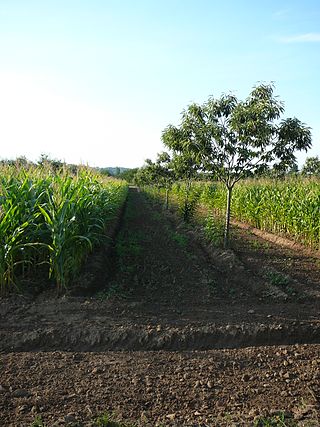
Agroforestry is a land use management system in which combinations of trees or shrubs are grown around or among crops or pastureland. Agroforestry combines agricultural and forestry technologies to create more diverse, productive, profitable, healthy, and sustainable land-use systems. There are many benefits to agroforestry such as increasing farm profitability. In addition, agroforestry helps to preserve and protect natural resources such as controlling soil erosions, creating habitat for the wildlife, and managing animal waste. Benefits also include increased biodiversity, improved soil structure and health, reduced erosion, and carbon sequestration.
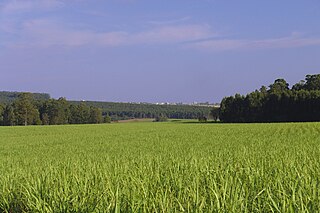
Bioenergy is energy made or generated from biomass, which consists of recently living organisms, mainly plants. Types of biomass commonly used for bioenergy include wood, food crops such as corn, energy crops and waste from forests, yards, or farms. The IPCC defines bioenergy as a renewable form of energy. Bioenergy can either mitigate or increase greenhouse gas emissions. There is also agreement that local environmental impacts can be problematic.
Energy forestry is a form of forestry in which a fast-growing species of tree or woody shrub is grown specifically to provide biomass or biofuel for heating or power generation.

Energy crops are low-cost and low-maintenance crops grown solely for renewable bioenergy production. The crops are processed into solid, liquid or gaseous fuels, such as pellets, bioethanol or biogas. The fuels are burned to generate electrical power or heat.
Olevano di Lomellina is a comune (municipality) in the Province of Pavia in the Italian region Lombardy, located about 45 km southwest of Milan and about 35 km west of Pavia.

Biomass, in the context of energy production, is matter from recently living organisms which is used for bioenergy production. Examples include wood, wood residues, energy crops, agricultural residues including straw, and organic waste from industry and households. Wood and wood residues is the largest biomass energy source today. Wood can be used as a fuel directly or processed into pellet fuel or other forms of fuels. Other plants can also be used as fuel, for instance maize, switchgrass, miscanthus and bamboo. The main waste feedstocks are wood waste, agricultural waste, municipal solid waste, and manufacturing waste. Upgrading raw biomass to higher grade fuels can be achieved by different methods, broadly classified as thermal, chemical, or biochemical.
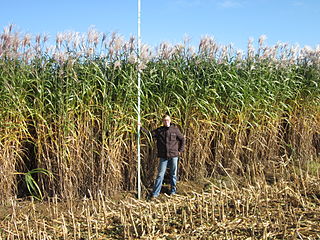
Miscanthus × giganteus, also known as the giant miscanthus, is a sterile hybrid of Miscanthus sinensis and Miscanthus sacchariflorus. It is a perennial grass with bamboo-like stems that can grow to heights of 3–4 metres (13 ft) in one season. Just like Pennisetum purpureum, Arundo donax and Saccharum ravennae, it is also called elephant grass.
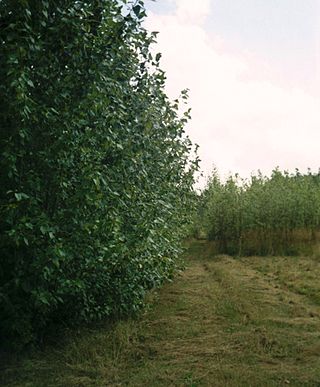
Short rotation coppice (SRC) is coppice grown as an energy crop. This woody solid biomass can be used in applications such as district heating, electric power generating stations, alone or in combination with other fuels. Currently, the leading countries in area planted for energy generation are Sweden and the UK.
The following outline is provided as an overview of and guide to forestry:

Biomass heating systems generate heat from biomass. The systems may use direct combustion, gasification, combined heat and power (CHP), anaerobic digestion or aerobic digestion to produce heat. Biomass heating may be fully automated or semi-automated they may be pellet-fired, or they may be combined heat and power systems.
Treethanol is an ethanol fuel made from trees.
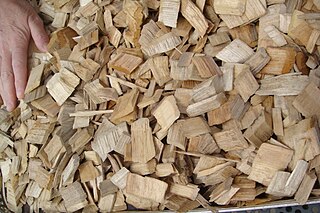
Woodchips are small- to medium-sized pieces of wood formed by cutting or chipping larger pieces of wood such as trees, branches, logging residues, stumps, roots, and wood waste.
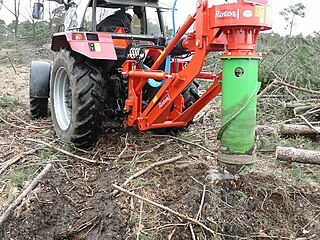
In plantation forests in parts of Europe, the tree stumps left after felling are now sometimes pulled out of the ground to supply wood fuel for biomass power stations. The stump is the base of the trunk and the attached woody roots. Tree stumps and roots are extracted using a hydraulic head on a tracked excavator or with a mechanical head equipped by a special tool for tractors. Stump harvesting is expected to provide an increasing component of the woody material required by the woody biomass power sector in Europe.

Carbon farming is a name for a variety of agricultural methods aimed at sequestering atmospheric carbon into the soil and in crop roots, wood and leaves. The aim of carbon farming is to increase the rate at which carbon is sequestered into soil and plant material with the goal of creating a net loss of carbon from the atmosphere. Increasing a soil's organic matter content can aid plant growth, increase total carbon content, improve soil water retention capacity and reduce fertilizer use. Carbon farming is one component of climate-smart agriculture.

Reinhart Jan Maria Ceulemans is an emeritus professor of Ecology and previous director of the Research Center of Excellence PLECO of the University of Antwerp. He has been vice-dean of the Faculty of Sciences at the University of Antwerp, and was a visiting professor at the University of Washington, Seattle, USA (1987-1988), at the Université Paris-Sud XI, Orsay and at the University of Ghent. He officially retired in October 2019 and is now a visiting professor at the University of Antwerp (Belgium), a researcher at CzechGlobe Academy of Sciences in Brno and an international consultant to the Slovenian Forestry Institute.
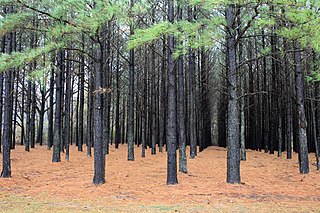
A tree plantation, forest plantation, plantation forest, timber plantation or tree farm is a forest planted for high volume production of wood, usually by planting one type of tree as a monoculture forest. The term tree farm also is used to refer to tree nurseries and Christmas tree farms.